
The International Code of Nomenclature for algae, fungi, and plants (ICN) is the set of rules and recommendations dealing with the formal botanical names that are given to plants, fungi and a few other groups of organisms, all those "traditionally treated as algae, fungi, or plants". It was formerly called the International Code of Botanical Nomenclature (ICBN); the name was changed at the International Botanical Congress in Melbourne in July 2011 as part of the Melbourne Code which replaced the Vienna Code of 2005.
Warren Herbert Wagner Jr., known as Herb Wagner, from his middle name, "Herbert," was an eminent American botanist who was trained at Berkeley with E.B. Copeland and lived most of his professional career in Michigan.

Epilobium is a genus of flowering plants in the family Onagraceae, containing about 197 species. The genus has a worldwide distribution. It is most prevalent in the subarctic, temperate and subantarctic regions, whereas in the subtropics and tropics Epilobium species are restricted to the cool montane biomes, such as the New Guinea Highlands.

Ludwigia is a genus of about 82 species of aquatic plants native to Central and South America with a cosmopolitan but mainly tropical distribution.
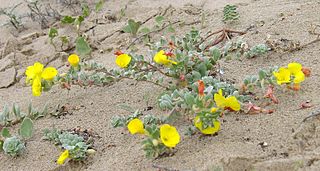
Camissoniopsis cheiranthifolia, the beach suncup or beach evening primrose, is a species of the evening primrose family and is native to open dunes and sandy soils of coastal California and Oregon.

Oenothera curtiflora, known as velvetweed, velvety gaura, downy gaura, or smallflower gaura, is a species of flowering plant native to the central United States and northern Mexico, from Nebraska and Wyoming south to Durango and Nuevo Leon.
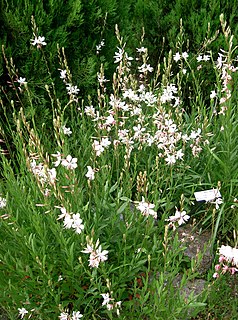
Gaura is a genus of flowering plants in the family Onagraceae, native to North America. The genus includes many species known commonly as beeblossoms. Recent genetic research has shown that the genus is paraphyletic unless the monotypic genus Stenosiphon is included within Gaura, increasing the number of species in the genus to 22.

Chamaenerion is a genus of flowering plants in the family Onagraceae. It has sometimes been included in the genus Epilobium. Members of the genus may be called willowherbs, or fireweeds, based on a common name used for C. angustifolium. They are upright herbaceous perennials, growing from a woody base or from rhizomes, with racemes of usually purple to pink flowers. All species are found in the northern hemisphere. Most occur in moist habitats; C. angustifolium is the exception, favouring disturbed ground.

Oenothera suffrutescens is a species of flowering plant in the evening primrose family known as scarlet beeblossom and scarlet gaura.
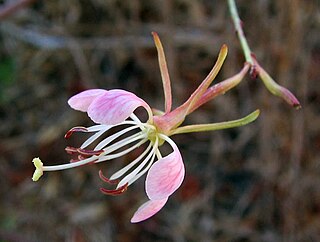
Gaura sinuata is a species of flowering plant in the evening primrose family known by the common names wavyleaf beeblossom and Red River gaura. In 2007 the species, along with the genus Gaura was reclassified in the genus Oenothera. This species then becomes O. sinuosa in Oenothera Section Gaura.
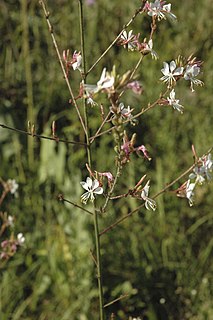
Oenothera guara, formerly known as Gaura biennis, the biennial gaura or biennial beeblossom, is a North American flowering plant that can reach 6 ft (1.8 m) in height at maturity. Its upper half is made up of flowering stems, which are covered with soft, white hairs. It has light pink colored flowers, which turn a vibrant red/pink color in the late summer to early fall seasons. These colors make this plant attractive to butterflies and bees, and are in full bloom just before many fall plant species begin to bloom.

Camissoniopsis is a plant genus in the evening primrose family (Onagraceae).
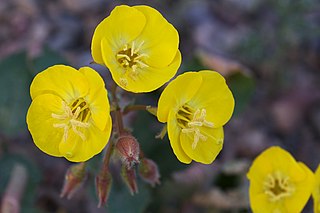
Chylismia is a plant genus in the evening primrose family Onagraceae.

Oenothera tetraptera, known as fourwing evening primrose, is a species of flowering plant in the evening primrose family (Onagraceae) native to the Americas. It has widely naturalized in other areas, including southern Africa, Europe, Asia, and Oceania.

Oenothera suffulta, known as roadside gaura, honeysuckle gaura, or kisses, is a flowering plant in the primrose family, Onagraceae. It is endemic to the United States, in Texas and southern Oklahoma.

Eremogone is a genus of flowering plants in the family Caryophyllaceae, native to western North America, northern Asia, eastern Europe and northeastern Africa. Attempts to resolve taxonomic relationships within the Caryophyllaceae have resulted in the enlargement of Eremogone with species from other genera.
Warren Lambert Wagner is an American botanist, a curator of botany, and a leading expert on Onagraceae and plants of the Pacific Islands, especially plants of the Hawaiian Islands.
Trigonopterum is a genus of flowering plants belonging to the family Asteraceae.














